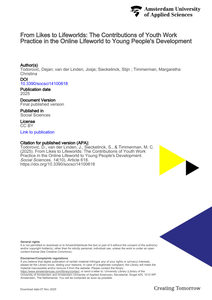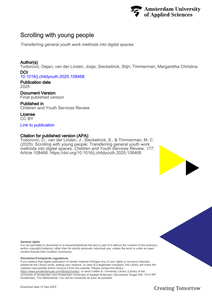The online environment, where the boundaries between the domains of home, school, work, and leisure are blurred, poses new challenges for youth work practice. Due to limited research on this subject matter, the theoretical underpinnings of the online youth work practice are constrained. The fulfilment of youth work’s aims online, the position it can take in the online context, and its relation to its partners in the online lifeworld need a theoretical base. This paper seeks to analyse the role of youth work in the online lifeworld according to adolescents and youth work’s partners. The research was conducted in the Netherlands in collaboration with 14 youth work organisations. A qualitative research design was used: group conversations with young people and semi-structured interviews with youth work’s partners (i.e., parents, schools, informal networks, neighbourhood support teams, police, and municipal officials). The findings indicate that youth work in the online lifeworld, according to the respondents, is part of the general youth work practice, with a primary role of addressing the developmental needs of young people and creating new developmental opportunities. This role is expected to be fulfilled by engaging and connecting with young people in the online lifeworld and providing them instrumental, informational, socioemotional, and cognitive support. To do so, according to the partners, youth workers can make use of their vantage position in the online relationship with adolescents in order to access online information relevant for support and prudent prevention aimed at adolescents’ development. This vantage position may potentially encourage a collaboration between young people and partners, and between the online and offline youth work practice.
DOCUMENT

As youth workers increasingly offer support and guidance within digital environments, the question arises as to what impact this support has on the (online) lives of young people. This paper explores the contribution of youth work practice in the online lifeworld on young peoples’ development, building on previous studies concerning youth work outcomes and the developmental needs of young people. A qualitative research design was employed, including digital diaries of youth workers and semi-structured interviews with both young people (N = 37) and youth workers (N = 25). The findings highlight the role of youth work in helping young people navigate social media; develop new skills, talents, and social connections; and increase awareness of online risks. Youth workers also support young people in coping with negative online experiences, including loneliness and mental health challenges. The contribution of online youth work is less visible in certain aspects of developmental needs, namely online safety and privacy, self-image, and assessing online information. This paper concludes by emphasising the need for further research into the long-term impact of youth work in the online lifeworld, particularly in light of rapid technological developments, the growing influence of artificial intelligence, and the increasing involvement of youth in digital forms of crime. The findings described in this study can form a base for future research to better understand the impact of these emerging issues on youth development and youth work practice, as well as to develop appropriate interventions.
DOCUMENT

The online lifeworld gives adolescents various opportunities to meet their developmental needs. Not all young people benefit from these opportunities. They encounter negative experiences, have difficulties fulfilling their needs and engage in risky and harmful behaviours in the online lifeworld. This poses challenges for Dutch youth work professionals, as little is known about the digital lives of Dutch adolescents and the challenges they encounter when meeting their developmental needs in the online lifeworld. In this qualitative study, a photovoice method was used to collect screenshots from adolescents (N = 175) concerning their experiences and needs in the online lifeworld. Six types of developmental needs in the online lifeworld were distinguished. The article concludes that understanding how adolescents use online affordances to fulfil their developmental needs is a starting point for all youth work professionals in providing adequate support to adolescents in the online lifeworld.
DOCUMENT
With the increasing significance of the online lifeworld in the lives of adolescents, youth work must adapt its methods to support young people’s personal development and social participation in this hybrid online space. To date, there is limited knowledge on how youth workers can effectively employ methodical actions in the online environment. This paper draws on established offline youth work methods to explore their potential transferability to the online context. The research question guiding this study is: How can offline youth work methods be used in the online lifeworld to support adolescents’ developmental needs? Using the Change Laboratory method, 26 youth workers from 14 youth work organisations in the Netherlands participated in this research. The findings suggest that while offline methods provide a valuable resource, they cannot be directly transferred to the online context without adaptation. Instead, they offer a framework for seven specific methodical actions that can be adapted or developed for the online context. They are: 1) Increasing online visibility and accessibility, 2) Orienting, 3) Signalling, 4) Making contact, 5) Building meaningful relationships, 6) Assessing needs, and 7) Providing support. By identifying these seven methodical actions which are crucial for addressing the developmental needs of adolescents online, this paper contributes to the growing body of knowledge on youth work in the online lifeworld.
DOCUMENT

When it comes to hard to solve problems, the significance of situational knowledge construction and network coordination must not be underrated. Professional deliberation is directed toward understanding, acting and analysis. We need smart and flexible ways to direct systems information from practice to network reflection, and to guide results from network consultation to practice. This article presents a case study proposal, as follow-up to a recent dissertation about online simulation gaming for youth care network exchange (Van Haaster, 2014).
DOCUMENT

A case study and method development research of online simulation gaming to enhance youth care knowlegde exchange. Youth care professionals affirm that the application used has enough relevance as an additional tool for knowledge construction about complex cases. They state that the usability of the application is suitable, however some remarks are given to adapt the virtual environment to the special needs of youth care knowledge exchange. The method of online simulation gaming appears to be useful to improve network competences and to explore the hidden professional capacities of the participant as to the construction of situational cognition, discourse participation and the accountability of intervention choices.
DOCUMENT

The present study evaluates the Youth Initiated Mentoring (YIM) approach in which families and youth care professionals collaborate with an informal mentor, who is someone adolescents (aged twelve to twenty-three) nominate from their own social network. The informal mentor can be a relative, neighbour or friend, who is a confidant and spokesman for the youth and a co-operation partner for parents and professionals. This approach fits with the international tendency in social work to make use of the strengths of families’ social networks and to stimulate client participation. The current study examined through case-file analysis of 200 adolescents (YIM group n ¼ 96, residential comparison group n ¼ 104) whether the YIM approach would be a promising alternative for out-of-home placement of youth with complex needs. A total of 83 per cent of the juveniles in the YIM group were able to nominate a mentor after an average of thirty-three days. Ninety per cent of the adolescents in the YIM group received ambulatory treatment as an alternative for indicated out-of-homeplacement, while their problems were largely comparable with those of juveniles in Dutch semi-secure residential care. Results suggest that the involvement of important non-parental adults may help to prevent out-of-home placement of adolescents with complex needs.
MULTIFILE

The Sport Empowers Disabled Youth 2 (SEDY2) project encourages inclusion and equal opportunities in sport for youth with a disability by raising their sports and exercise participation in inclusive settings. It was important to ensure that the authentic views, wishes and feelings of youth with a disability regarding inclusion in sport were attained. Therefore, online focus groups were conducted with youth with a disability, their parents and sport professionals in Finland, Lithuania, Portugal and The Netherlands. Seven themes regarding inclusion in sport have been identified from these interviews: having a choice, sense of belonging, everyone can participate, same rights and equality, acknowledge that everyone is unique, inclusion is an ongoing process and terminology (language) is challenging.
DOCUMENT

In de eerste twee delen van het proefschrift vindt u informatie over online opvoedingsondersteuning in het algemeen. Welke studies zijn daarover gepubliceerd? Hoe zien de onderzochte online programma’s voor ouders eruit? Welke kenmerken hebben ze? Hoe effectief zijn ze? In de drie andere delen gaan we dieper in op het eenmalig e-mailconsult. Er zijn veel organisaties in Nederland die ouders de gelegenheid bieden om een advies per e-mail te ontvangen, vaak via een web-formulier of een button op een website. Kunnen beroepskrachten deze vorm van online communicatie gebruiken om ouders te begeleiden naar méér empowerment? In deze brochure leest u een beknopte samenvatting van het proefschrift.
DOCUMENT

The Sport Empowers Disabled Youth 2 (SEDY2) project encourages inclusion and equal opportunities in sport for youth with a disability by raising their sports and exercise participation in inclusive settings. This SEDY2 Inclusive (Online) Focus Group Guidance aimed to develop an easy-to-use guidance document on how to deliver inclusive focus groups to attain the authentic views, wishes and feelings of children and youth with a disability about inclusion in sport in practice. This guidance document was produced in order to support other practitioners in conducting inclusive focus groups. The focus group guidance can easily be adapted to cover other topics and can also be used effectively with all (young) people.
DOCUMENT
